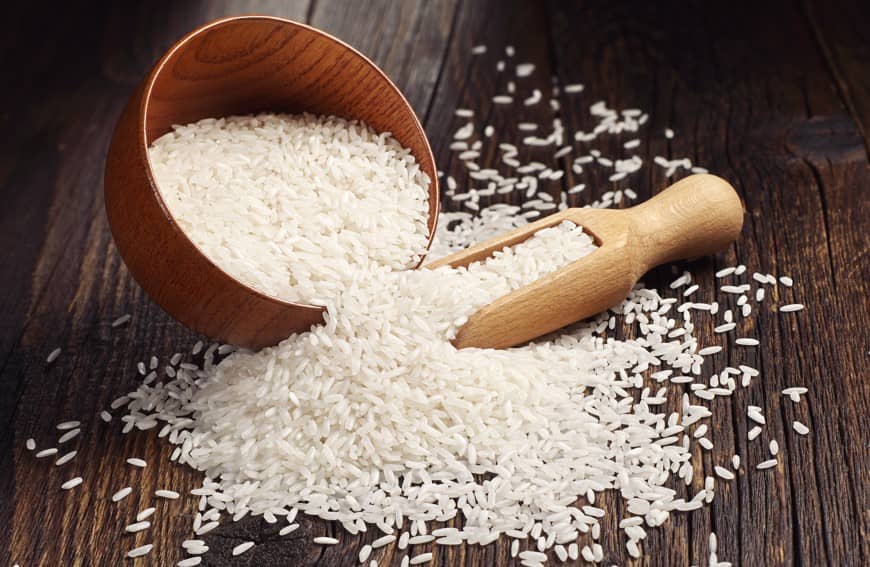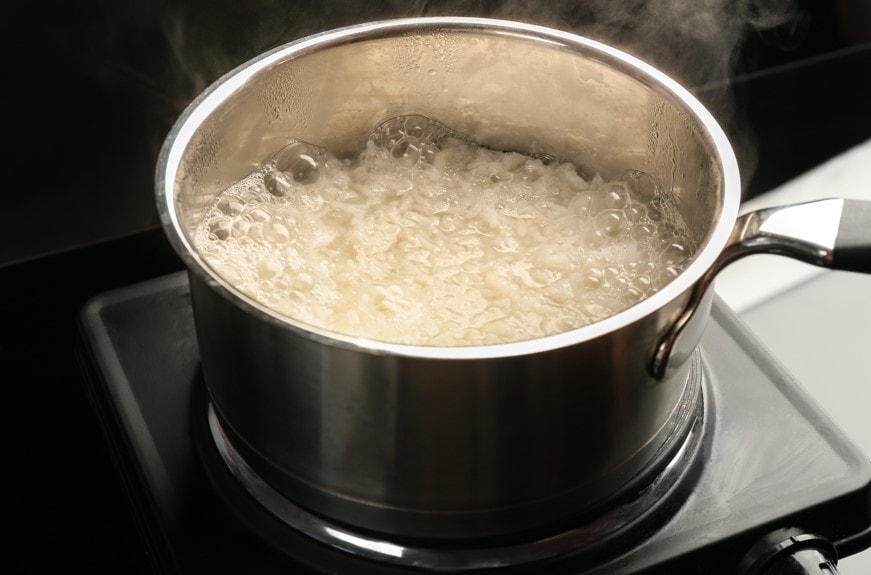This post may contain affiliate sales links. Please read my disclosure policy.

Rice is, without a doubt, a staple in the kitchen – there are so many different dishes you can make with it, coming from all over the world, that even if you decided to make one every day for a year, it probably wouldn’t be enough time to try them all!
Still, cooking the perfect rice is something that not many people can do. That might have to do with the fact that there’s not one universal answer to the question of how to cook rice – it all depends on the type of rice you are using in your recipe.
For that reason, I decided that it might be useful to prepare a comprehensive guide on how to properly prepare different types of rice. That way, no matter which one you’ll have to deal with, you will know exactly what to do.
Types of Rice
As far as kinds of rice are concerned, there are three main ones – short-grain rice, long-grain rice, and medium-grain rice. They differ from each other in shape and starchiness, as well as in uses.
Short-grain rice is typically round in shape, and its length and width are more or less the same. It has a high starch content, which is why the grains stick to each other when cooking. In the kitchen, you can usually find it in dishes that require a stickier texture, like sushi or risotto.
Long-grain rice, on the other hand, is longer than it is wide (even up to 5 times). Since the starch content is lower, the grains typically stay separated, which is why it is a good choice for dishes such as pilaf or any fried rice recipe.
Medium-grain rice, as you can guess, falls in between those two. It’s longer than short-grain rice (about three times its width) and has a slightly sticky texture. Some dishes that it is best used in include paella, as well as some desserts.
Varieties of Rice
Rice comes in many varieties. Some of the most common ones that you will typically find in a grocery store include:
- White rice – the most commonly used variety of rice. Only the white endosperm remains while the husk, bran, and germ are removed.
- Brown rice – in this variety of rice, only the outer husk is removed while the rest remains. Many people like it due to its chewy texture and nutty flavor.
- Basmati rice – this is a long-grain rice variety that is mostly used in Indian and Pakistani cuisine, mainly due to the fact that when cooked, it expands in length while remaining separate.
- Jasmine rice – originating from Asia, specifically from Thailand, jasmine rice is known for its slightly sweet flavor.
- Arborio rice – a type of short-grain rice that is mostly used in Italian cuisine, particularly dishes such as risotto.
- Parboiled rice – if rice is of parboiled variety, it means that it underwent a steaming or parboiling process before milling, which takes the nutrients from the bran and moves them into the endosperm. As a result, parboiled rice is more nutritious than regular white rice.
These are just a few of the available varieties of rice. I chose the ones that I would consider to have the highest chances of encountering in recipes, but there are plenty more, including black rice, sushi rice, or red rice.
How to Cook Rice on Stove

Now, let’s move on to the reason why you even ended up here – how to make rice? As I already mentioned, it all depends on which type of rice you will be using for your dish. I will focus on the most common way of preparing rice, which is cooking rice on the stove.
Something many people ask themselves when cooking rice is whether you should add salt to it. The truth is that it all depends on your personal preference, as there are some individuals who either don’t like to add it or just can’t, usually for medical reasons. If you’re not one of them, then keep in mind that you should add salt before the rice is cooked – ideally before you add it to the boiling water.
You might also be wondering how much salt you should add. Well, again, that is something that depends on your taste. However, I think that a good rule of thumb is to add around ½ to 1 teaspoon of salt for every cup of rice you’re cooking.
Long-Grain Rice
Here’s how you can cook long-grain rice on stove:
- Prepare your rice and rinse it thoroughly in cold water until it becomes clear.
- Use a 1:2 rice-to-water ratio. Bring your water to a boil before adding the rice, stir the rice once, and change the heat from high to low.
- Cover and cook for 18 to 20 minutes or until rice absorbs the water. Once you turn the heat off, cover it and let it sit for 5 minutes so that the rice can steam and fluff up.
Medium-Grain Rice
Cooking medium-grain rice looks very similar to long-grain rice, with the main difference being the water-to-rice ratio used.
- Rinse your rice if you’re using a variety that needs to be rinsed. There are some that are better off left unrinsed, such as Arborio rice, as the extra starch that would be washed off in the process helps create a creamy texture, perfect for some of the dishes.
- In the case of medium-grain rice, the desired rice-to-water ratio is 1:1.5. Bring water to a boil, add rice, and reduce to a simmer. Cover your rice up and wait until the water is absorbed, which typically takes between 15 to 20 minutes. Let it rest for a few minutes.
Short-Grain Rice
Again, cooking short-grain rice looks almost the same as the two other types, just with a different water-to-rice ratio.
- Rinse the rice by adding enough water to cover the grains. Rinse them until the water is clean.
- Depending on the variety of rice, it might be beneficial to leave it to soak for about 30 minutes – this is the case for sushi rice and most of the other East Asian varieties.
- Use a 1:1 rice-to-water ratio. Bring water to a boil, reduce the heat from high to low, cover the rice, and let it simmer for about 15 minutes. Do not lift the lid up when cooking the rice, and once you remove it from the heat, let it sit for about 10 minutes.
How to Fix Common Mistakes When Cooking Rice
If you burned or undercooked your rice (happens to the best of us), nothing’s lost yet – you can easily fix it.
Undercooked Rice
There could be several reasons why your rice is undercooked, including making the heat too high, taking the lid off too soon, or even not using it at all. Whatever the case, if your rice is far from cooked, it can be easily fixed. Simply add about half a cup of water and put it on a simmer with a lid on. Don’t try to rush the process by turning up the heat or you’ll go back to where you started.
Burned Rice
If you let your rice cook for too long, one of the first things you should do is assess just how much damage it has done. If your rice is tarmac black, then, unfortunately, there’s nothing you can do to fix it – you’ll need to toss it out.
However, if your rice is just slightly brown, smells toasty, and looks quite crispy, you can still eat it – in fact, there are quite a few cuisines in which crispy bottom is desired and even has its name. An example of such is Korean cuisine, where the slightly browned crust that forms at the bottom of the pot after cooking it over direct heat is called nurungji.
Watery Rice
If your rice is too watery for your taste, don’t try to cook the water off. Instead, take a strainer and, just like you would with pasta, drain the excess water.
Salty Rice
If you used too much salt when cooking rice, the best way to fix it is by cooking another portion, but this time not adding any salt. Once your second batch is done, just mix the two together using a fork so it’s still fluffy and light.
The Bottom Line
Cooking a perfect batch of rice is not as hard as it might seem. The key is to get the rice-to-water ratio right, as using too much or too little water can result in your rice being either undercooked or burned.
And if you’re looking for some inspiration for how to use your rice, don’t hesitate to take a look at my recipes. I’m sure at least one of them we’ll catch your eye, and you’ll have the opportunity to test our knowledge in practice! Bon Appetit!




